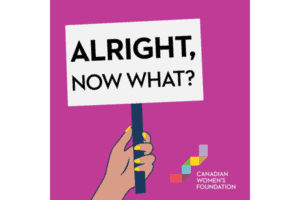 The Canadian Femicide Observatory for Justice and Accountability recently reported that, in 2020 and 2021, the rate of femicide – murders of women because they are women – has been on the rise. In Canada, a woman is killed by her current or former partner an average of every 6 days. That’s a pretty frightening and unacceptable number. And that was the number before the pandemic’s spike in risk of abuse.
The Canadian Femicide Observatory for Justice and Accountability recently reported that, in 2020 and 2021, the rate of femicide – murders of women because they are women – has been on the rise. In Canada, a woman is killed by her current or former partner an average of every 6 days. That’s a pretty frightening and unacceptable number. And that was the number before the pandemic’s spike in risk of abuse.
What is femicide, exactly? What can we do to end this completely preventable form of gender-based violence as we move into a new year?
Anuradha Dugal, Vice President of Community Initiatives at the Canadian Women’s Foundation and a representative of the Canadian Femicide Observatory for Justice and Accountability, joins us to speak about this issue.
Content note: this episode features discussion of femicide and intimate partner abuse. If you need access to support, you can find a list of services that may be useful to you on our website.
The Canadian Women’s Foundation acknowledges the support of Women and Gender Equality Canada.
Transcript
00:00:00 Andrea
Hi, I’m Andrea.
The Canadian Femicide Observatory for Justice and Accountability recently reported that, in 2020 and 2021, the rate of femicide has been on the rise.
But what is femicide exactly? And what can we do to end this completely preventable form of gender-based violence?
Welcome to Alright, Now What?, a podcast of the Canadian Women’s Foundation. We put an intersectional feminist lens on stories that make you wonder “Why is this still happening?” We explore systemic roots and strategies for change that will move us closer to the goal of gender justice.
The work of the Canadian Women’s Foundation and our partners takes place on traditional First Nations, Métis, and Inuit territories. We are grateful for the opportunity to meet and work on this land. However, we recognize that land acknowledgements are not enough. We need to pursue truth, reconciliation, decolonization, and allyship in an ongoing effort to make right with all our relations.
00:01:01 Andrea
Femicide is all too common and it’s most often committed by male intimate partners. In Canada, a woman is killed by her present or former partner, an average of every six days. That’s a pretty frightening and unacceptable number, and that’s the number before the pandemic spike in risk of abuse.
Anuradha Dugal, Vice President of Community Initiatives at the Canadian Women’s Foundation and a representative of the Canadian Femicide Observatory for Justice and Accountability, joins us to speak about this issue.
00:01:33 Anuradha
So femicide means being killed basically because you’re a woman.
In most cases, that means that a woman is at particular danger from femicide if she is in a situation of domestic violence, so experiencing harm or abuse from a partner. And we say femicide to identify that this is really the killing of women over say homicide, which is a term that is also used more in legal or police settings.
But we choose to say femicide because it’s important that these are murders that happen specifically because of a particular set of circumstances, and risk factors, as you asked about.
So, the risk factors are violence, abuse and different forms of power and control within abusive relationships and some of the things we’ve learned about femicide over the years are, for example, there’s a very, very high risk of increased severe and fatal violence when someone is trying to leave an abusive relationship. That really is a sort of a pivot point in the levels of fatality.
You know the severity of violence and the potential for a fatal outcome is always related to sort of key points of tension in a relationship. So sometimes pregnancy can be a case where it increased, and it’s a higher risk, higher danger, sometimes different kinds of pressures on the family can lead to greater risks, but the highest risk is always at the point at which someone who’s being abused chooses to leave.
00:03:14 Andrea
In the Toronto Star, they’ve recently noted a really disturbing trend of higher rates of femicide in 2020 and 2021. Just tell us a bit about what we’re seeing and why you think this might be happening.
00:03:25 Anuradha
In 2021, we saw that the numbers had gone up for femicide and we do think that this is largely due to the pandemic.
We had seen an uptick the previous year, obviously the first year of the pandemic in 2020, and at that time it was very hard to say whether it was due to the pandemic or not. And the second report that we just, that the Canadian Femicide Observatory just released, it explains that in the first half of 2021 there has been a pretty severe uptick in femicide that you really can assign to some of the effects of the pandemic.
So, for example, people are shut up in their homes, not all the time of course, because a lot of the social distancing rules have relaxed, but certainly in the first half of 2021 this was still going on in many parts of the country. And that’s a circumstance where somebody who uses harm in a relationship, who’s violent, they can use that circumstance of being in the same place all day long as an additional motive and justification for oppressive behavior, for monitoring the partner, for being able to follow every single thing they’re doing and using the pandemic as an excuse for violence and abuse. So using pandemic measures to say you can’t go anywhere, you’re not allowed to see anybody, you must stay here, using things like limiting access to medication or to PPE, or to other kinds of ways of keeping yourself safe, that can be controlled in that locked down situation. And also using the fear that somebody has, of potentially infecting somebody else, as an excuse to say
You’re not doing a good enough job at home.
You’ve got to clean more.
You’ve got to do this more.
You’ve got to do that more.
You’re not doing enough.
All of those things are the kinds of psychological abuse and emotional abuse that is frequently used in a relationship to control another person. So those opportunities were heightened in the pandemic at the same time as access to help and support being reduced because of the messages that were coming out that you were supposed to stay home and not necessarily access services.
That, that’s a terrible mix.
That’s a lethal mix for many, many women in Canada, and we saw in the first half of the year an uptick in that, those numbers. I think it was about a half again of what you would normally expect for that time of year and it’s horrible to use that term normally expect. But in Canada we do have these numbers that year over year a woman is killed every six days from being in an abusive relationship. And even when you add in women and family members and children, somebody is killed every three days in Canada because of abuse and violence in relationships.
So it really is something that appears to be much more lethal during this period of the pandemic because of all those additional factors that aren’t in play in other circumstances.
00:06:36 Andrea
What role do you think people play who surround a violent situation and maybe recognizing that something is happening?
What role do they play to reduce the risks of femicide perhaps?
And what skills and competencies and traits can they employ to take an effective posture of stigma free support?
00:06:56 Anuradha
I think one of the most important words in everything that we’re saying is the idea of stigma free support.
So, the very first thing that you can do when you see that somebody is being harmed or is being, you know, emotionally blackmailed or is in a situation where they’re being harmed psychologically and physically is to ask them what they need.
It must be done very confidentially, obviously, because if it’s done in front of family setting or in you know in a sort of more public setting, of course, that raises the possibility of additional violence happening or worse violence happening, so it has to be addressed very, very carefully, but being done confidentially, quietly and following the lead of the person who needs the help. Those, that’s the way to go.
Non-judgmental, you said stigma free and that means being non-judgmental.
This is never the fault of the person who’s being harmed.
In no way can you ever even suggest that that’s the possibility that they could be to blame, because that is what they’re being told all the time by the person who is harming them. It is poisonous messaging that they receive every day. And our job as people who are stepping in to try and help is to undo that messaging and to help them see that they are able to be the person they want to be and that they are not the person that they are being told they are by the abuser or the person who’s harming them in their relationship. That’s a very very typical trait that we see that has to be undone.
I think the other thing that’s really important in being able to say you want to help is to already have some things in mind, so it’s not necessarily enough to say I’m here to help, what can I do?
That’s the good place to start.
But then after that it’s really important to have a couple of phone numbers.
Who would you call?
Who might you offer?
What phone number might you give this person to say
Here’s a crisis line. Call this number if something happens.
Or here’s the address of a place you can go, and you can sit down and talk to somebody about what’s happening to you, somebody who knows what you’re going through, someone who may have experienced it themselves, and those are really important messages to have.
And then the other thing is, there’s some things like really, that we always say, please don’t do this and please don’t say these things and one of the critical things to not say is why don’t you just leave?
Because that is a very damaging message.
It’s probably something that person has been asking themselves for years and has no answer to.
It’s not a helpful question to ask.
The question to ask is “how can I help you?” and maybe the question is “do you just want me to listen to you?”
That’s a fantastic place to start -being there, offering your support unreservedly is a very very healing start for anybody who’s experiencing violence and abuse.
And those are the sorts of things that you can learn and the Signal for Help Responder campaign is one of the places that you can learn some of those techniques, amongst a lot of other people who are also interested in helping and being available.
And it’s really critical that we know some of these things before we see harm happening because typically what happens when you see somebody in this situation, I’ve certainly been in this situation, is you freeze. You don’t know what to do. You’re stuck in a situation, you just feel awful and you get kind of churned up in your own reaction rather than being ready to step in and being a good helper.
So any kind of bystander situation, the way to be ready for that is to practice and to know like OK, these are the, these are the things I know I have to say in this setting. These are the things I’m prepared to do. This is the way that I know I can help.
And that means being ready to do that work yourself in advance of the possibility of this happening in your life to somebody you know and love.
00:11:14 Andrea
No harm in practicing.
No harm in trying and testing.
No harm in trying to learn something new.
That’s really powerful.
Now I’ve got a big question for you.
What are the three things, you feel, Canada needs to do to reduce rates of femicide just at large, pandemic contexts and even before?
And particularly, paying attention to those who might be at highest risks. And we know that the rates are higher for indigenous women. Rates are higher for gender-based violence when it comes to women with disabilities.
So give us a sense of some structural changes that need to happen.
00:11:41 Anuradha
So, the first thing I would say is that the National Action Plan on gender-based violence needs to take femicide very seriously. It needs to be part of all of the provincial action plans against to end violence against women. Being ready to end femicide means being ready to identify when it could be happening and there’s a series of reviews that have been done in cases of femicide in many provinces that that have reported on some key risk factors in the cases that we’ve seen so far in Canada.
So, there are clear indications of when somebody might be considering lethal violence in an abusive relationship and some of those indications include things like thoughts of suicide and self-harm towards themselves and it includes pressures such as a job loss or family crisis outside of the abuse that is happening, it includes trauma that has happened in that family due to other forms of violence or migration or damaging experiences that are generational too.
And I think in the case of indigenous communities, that’s a really critical moment where we can say this is this is a community that’s experienced genocide? And so the rates of femicide are connected to those experiences of genocide. So, we have to address truth and reconciliation and decolonization before we can say we’re ready to really step in and stop the murders of indigenous women and girls. That’s a clear line that we have to take. And it’s been clear for many years now.
And Canada’s government has to step up and put into place a national action plan to address violence against indigenous women and girls specifically because the kind of violence they experience is different and it’s connected to racism and to colonization too.
So, those are those are some of the things that I would say are a sort of immediate steps, but I also think when we talk about femicide in the media or amongst ourselves. That’s a culture shift we need to make too. It’s got to stop looking at the behavior of the person who was killed and look at the behavior of the person who did the killing.
There is no excuse for that.
Somebody is responsible for that kind of violence.
And very often we see in stories a kind of justification for killing or something that sort of diffuses their responsibility. Very typical way it’s often done is, oh, it was a family drama, or this was a, you know, this was an argument that went out of hand.
It’s like no. Murder happens because somebody has made the decision to kill someone, and that is the way these femicides have to be treated also.
And then, the last thing I’d say is I think we need to talk a lot more to the people who work in shelters and work to help women, women’s advocates to work to help and a lot less to police and the legal services.
Again, very often when we’re thinking about femicide, we end up hearing what the police think about this or hearing about what the courts think about this.
I would like to hear personally a lot more from the people who are working directly on the front lines to end this violence.
00:11:29 Andrea
Do you know how to respond to the Signal for Help? to any sign or signal of abuse?
Go to signalresponder.ca to learn more and text signal to 540-540 to get a Signal for Help Responder’s Action Guide.
Our November 2021 poll found that 64% of people in Canada know a woman who’s experienced physical, emotional, or sexual assault, but many lack strong confidence and competency in knowing how to support them.
There is no better time to sign up to be a signal responder and get the tools and training we all need.
Go to signalresponder.ca to learn more and text signal to 540-540 to get a Signal for Help Responder’s Action Guide.
Please listen, subscribe, rate and review this podcast and share it with others.
If you appreciate this content, if you want to get in on the efforts to build a gender equal Canada, please donate today at canadianwomen.org and become a monthly donor. And thank you for being tireless in your support for gender justice.






